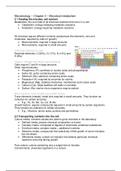Microbiology – Chapter 3 – Microbial metabolism
3.1 Feeding the microbe; cell nutrient
Metabolism; the sum total of all chemical reactions that occur in a cell.
• Catabolism; energy-releasing metabolic reactions
• Anabolism; energy-requiring metabolic reactions
All microbes require different nutrients (substances like elements, ions and
molecules, required by cells for growth)
• Macronutrients; required in large amounts
• Micronutrients; required in small amounts
Chemical makeup of a cell
Essential elements; C (50%), O (17%), N (13%) and
H (8%)
Carbon, nitrogen and other macronutrients
Cells require C and N in large amounts.
Other macronutrients;
• Phosphorus (P); synthesis of nucleic acids and phospholipids
• Sulfur (S); sulfur containing amino acids
• Selenium (Se); selenium containing amino acids
• Potassium (K); required by enzymes for activity
• Magnesium (Mg); stabilize ribosomes, membranes and nucleic acids
• Calcium (Ca); helps stabilize cell walls in microbes
• Sodium (Na; marine micro-organisms require sodium
Micronutrients; trace metals and growth factors
Trace elements (metals); metal ions required in small amounts. They function as
cofactors for certain enzymes.
• E.g.; Fe, Zn, Mn, Cu, Co, B, Mo
Growth factors; organic compounds required in small amounts by certain organisms.
They function as cofactors for certain enzymes.
• E.g.; Vitamins, amino acids, purines and pyrimidines.
3.2 Transporting nutrients into the cell
Culture media; nutrients solutes are used to grow microbes in the laboratory
• Defined media; precise chemical composition is known
• Complex media; composed of digests of chemically undefined substances
• Enriched media; complex media + additional nutrients
• Selective media; compounds that selectively inhibit growth of some microbes
but not others
• Differential media; contain an indicator that detects particular chemical
reactions occurring during growth.
Pure culture; culture containing only a single kind of microbe
Contaminants; unwanted organisms in a culture






